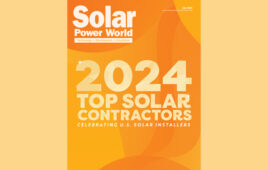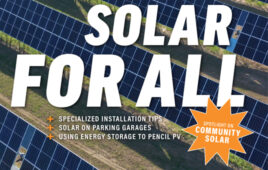WELCOME TO THE SOLAR+ DECADE
SOLAR POWER ALONE is capable of lowering electric bills and greening the environment, but for it to be most effective at keeping the lights on in this time of climate change and voluntary blackouts, it must be paired with storage. SEIA has proclaimed 2020 to 2030 to be the Solar+ Decade and set a goal for solar to comprise 20% of all U.S. electricity generation by 2030 instead of its current 2.7% share. The group plans to accomplish this ambitious goal through “aggressive collaboration” with stakeholders in wind, storage and other industries.
The solar industry continues to reach milestones on its own. According to Wood Mackenzie’s “2019 U.S. Solar Market Insight Report,” the utility solar pipeline hit a record of 37.9 GW in September 2019. Utilities like Ameren and companies like Microsoft contributed to this achievement with huge procurements, like Microsoft’s 150-MW solar array being built to power two data centers in Arizona.
The U.S. Energy Information Administration (EIA) found that solar, including small-scale PV systems, grew 13.7% in 2019 compared to the first eight months of 2018. Small-scale solar provided nearly one third of total solar generation and distributed solar as a whole grew more than any other energy source.
“It’s no surprise that the U.S. solar pipeline is surging as costs continue to fall and solar becomes the lowest cost option for utilities, corporations and families,” said Abigail Ross Hopper, president and CEO of SEIA. “However, as we push for solar to represent 20% of U.S. electricity generation by 2030, smart policies like an extension of the solar Investment Tax Credit will be critical to reach this goal.”
SEIA and other solar advocates are working hard to extend the ITC to make sure this growth continues in all solar sectors. Wood Mackenzie and SEIA forecasted that extending it would produce $87 billion in new private sector investment and add 113,000 more jobs over baseline estimates by 2030. It also found that an extension would generate an additional 82 GW of solar deployment over the next decade, with 63 GW coming from the utility-scale sector.
Residential solar also grew 3% quarter-over-quarter and 8% year-overyear in 2019 as it continued its rebound from 2018. Residential storage had a milestone year, hitting its biggest quarter ever in Q2 with 35 MW of installations.
“The nascent energy storage market in the U.S. continues to grow in fits and starts,” said Dan Finn-Foley, head of energy storage for Wood Mackenzie. “But signposts such as the record residential storage quarter, massive FTM pipeline growth and innovative policies such as the Massachusetts Clean Peak [Energy] Standard point toward an industry that is maturing and should stabilize at scale over the next two years.”
There’s no stopping solar, but as the climate changes and the effects compromise the grid in more and more ways, energy storage must be part of the equation.





““It’s no surprise that the U.S. solar pipeline is surging as costs continue to fall and solar becomes the lowest cost option for utilities, corporations and families,” said Abigail Ross Hopper, president and CEO of SEIA. “However, as we push for solar to represent 20% of U.S. electricity generation by 2030, smart policies like an extension of the solar Investment Tax Credit will be critical to reach this goal.””
The efficiency is exactly where that 20% solar PV generation is installed. Considering centralized generation facilities that have transformer step losses of from 15% to 25% end to end are not the most efficient generation resources to add to the grid. Every home, every business with solar PV and a smart ESS would make a larger energy efficiency difference than larger centralized solar PV installations that still have the grids intrinsic step power losses. It’s not just look at the grid and see what generation requirements are needed for the future. It’s look at the (technology) and see where it is most efficient to install and use.
This is one of the very ‘hot button’ arguments going on across the U.S.. Electric utilities say solar PV adopters are raising their neighbor’s electric rates, (because) solar PV adopters, (don’t) pay ‘their’ fair share of line and maintenance costs. Yet these same electric utilities want net billing instead of net metering. The utilities ignore the company’s ‘avoided costs’ that are not passed along to the non-solar ratepayers. When a neighbor generates excess solar PV energy and pushes it back onto the grid, it goes a very short distance and into the meter at your home. While YOU are actually powering at least part of the load in your home with solar PV energy, does the utility make any attempt to monitor this non-fueled electricity and remove the “fuel charge” from that power going through your meter? How about TD&D charges, how much ‘transmission’ line is used to get the power from the excess solar PV to your house? Does this honestly require a TD&D charge on the kWh of electricity you use that is non-fueled and local (next door) solar PV energy? If and when the utility achieves its goal of net billing for excess solar PV pushed back onto the grid, will the utility give the non solar ratepayer some respect or will they just sell the power at the ‘regular’ rate with all of those bogus fuel, TD&D charges to you? Yeah and the utility says, “what charges?”, we’re not overcharging you, we’re making it fair for all ratepayers. Yeah, riiiigggghhhhttttttt.